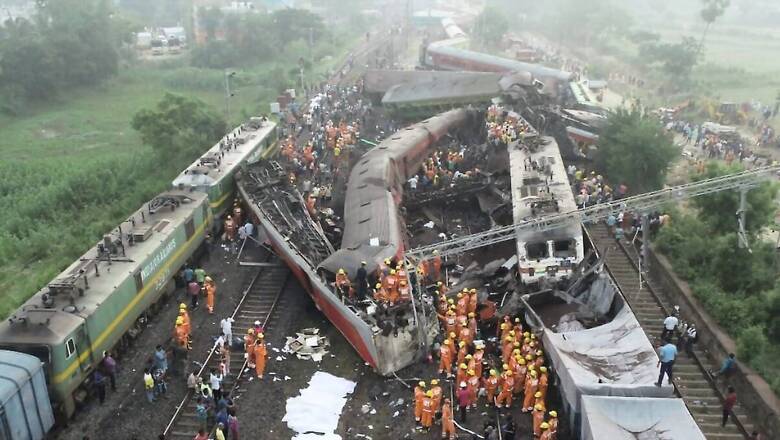Balasore Train Crash: Among Multiple Signalling Lapses Flagged in CRS Report, Focus on Two Incidents

views
The much-awaited Commission of Railway Safety (CRS) report on the Balasore train tragedy, that claimed the lives of 290 people and injured more than 1,000, has been submitted to the Railway Board. It carries testimonies from the interrogation of staff members and explores various aspects related to the site and railway assets.
Though railway officials have refrained from commenting on the report’s contents citing the ongoing CBI investigation, News18 obtained significant portions of the document through sources.
The report clearly states that the accident was a case of collision wherein the speedometer reading of the Coromandel Express abruptly dropped to zero. The collision involved the Coromandel Express, a Chennai-Kolkata passenger train, which entered the up-loop line near the Bahanaga Bazar railway station where a goods train was already stationed. The collision led to the derailment and knocked off the last few coaches of the Bengaluru-Howrah Superfast Express on another track.
“Lapses at multiple levels in the S&T (Signal & Telecommunication) Department were responsible for this accident,” the report said.
The investigation into the accident, one of the deadliest in the history of Indian Railways, was initially handed over to the Commissioner of Rail Safety (CRS) and then to the Central Bureau of Investigation. AM Chowdhary, Commissioner of Railway Safety, South Eastern Circle, was given charge of the inquiry.
“We won’t be able to comment or disclose the CRS report because of another ongoing CBI inquiry. Till the conclusion of CBI report, we will not consider commenting on it either,” said a railway official when approached for comment.
Sources, however, said the CRS report has cleared the cloud of confusion over the cause of the accident and that action will be taken soon.
What Led to the Accident?
Railway sources indicated that problems with the point/crossover before the signal made the Coromandel Express enter the loop line instead of the main line. The same has reportedly been confirmed by the CRS. The accounts of the loco-pilot and assistant loco-pilot along with the joint report of the supervisors after the accident, which said that the point was set in reverse while the signal was green for the main line, was taken into consideration.
“Derailment was not the initial cause of accident and it was quite clear from the beginning. The locomotive was not due for any inspection and this is very much mentioned by the CRS. The rolling stock or the track also had nothing to do with the accident and it is very clear in the report. Thus, it was only the signalling system that everyone was looking at,” said a senior officer privy to the developments.
Lapses In Signalling-Circuit-Alteration
The conclusion of the CRS report delves into the lapses in the signalling-circuit-alteration carried out at the north signal room of the station in the past and also during the replacement of Electric Lifting Barrier (ELB) for level crossing gate no 94. Somewhere down the line, this resulted in the wrong signal to the train.
According to the report, while mentioning the lapses, the safety officer pointed to the circuit shifting work that was done on account of cable fault back in 2018. This shifting was allegedly done without following the standard practice and there was wrong lettering on the terminals.
Similarly, the circuit for Electric Lifting Barrier (ELB) of Level Crossing (LC) 79 of Balasore Station, used for the modification of ELB circuit of LC-94 at Bahanaga Bazar Railway Station, was not suitable. There was no approved circuit diagram issued for the execution of ELB-replacement work of LC-94 which could prevent this mistake.
According to a railway official, these two lapses were responsible for the accident. The replacement work carried out by the S&T staff was impacted by these incidents, misleading them. Despite the point being set for the loop line, the signal showed green for the up-line, causing the Coromandel Express to proceed onto the loop line instead of the intended up-line.
Who is Responsible?
While the CRS report has mentioned the non-supply of circuit diagram for ELB replacement work, the responsibility of the accident has been placed on the Signal and Telecommunication Department. It has been categorically mentioned that lapses at multiple levels in the department were responsible for the accident. It has also been mentioned that had the Station Master told the S&T staff about the strange behaviour of the Crossover 17A/B, they could have found the problem in the wiring that connects to the electronic logic of the crossover. This could have averted the accident.
Importantly, notes on the events logged in the data logger from the same day indicated that point operation on the same day took more than the usual time at around 4:21pm. There was another abnormal occurrence in the change of status, which was possibly ignored.
While the Railways has not commented on the findings, it is important to note that these have been based on documents and sources from within the Railways. This report will be updated if and when the official version of the Railways is received.

















Comments
0 comment